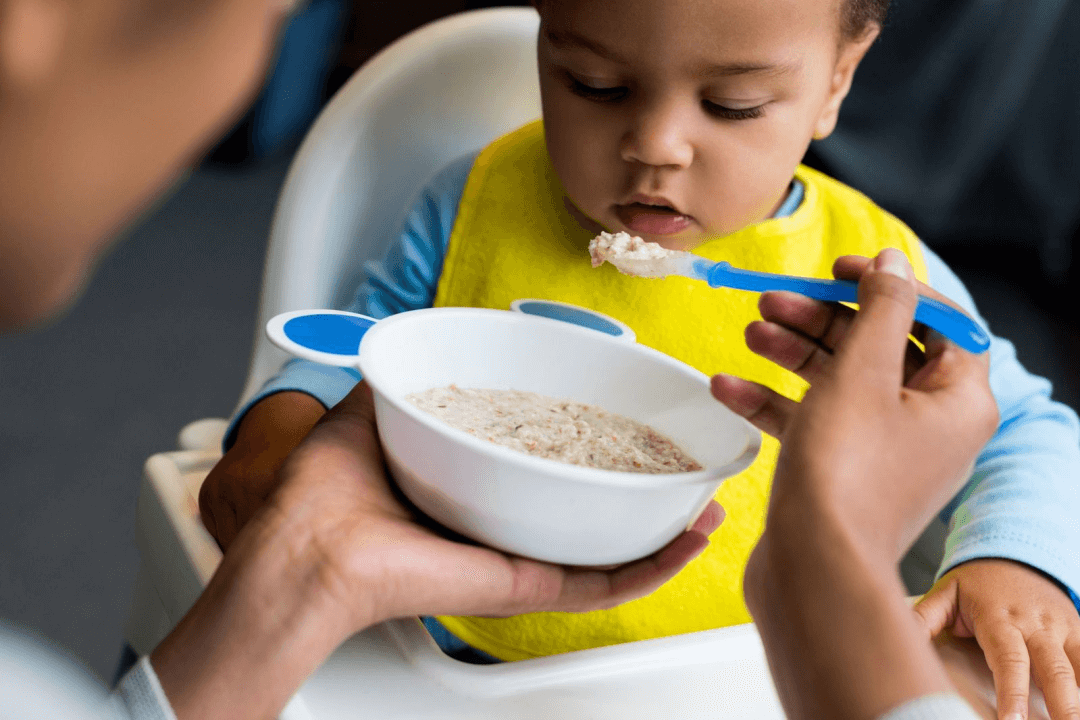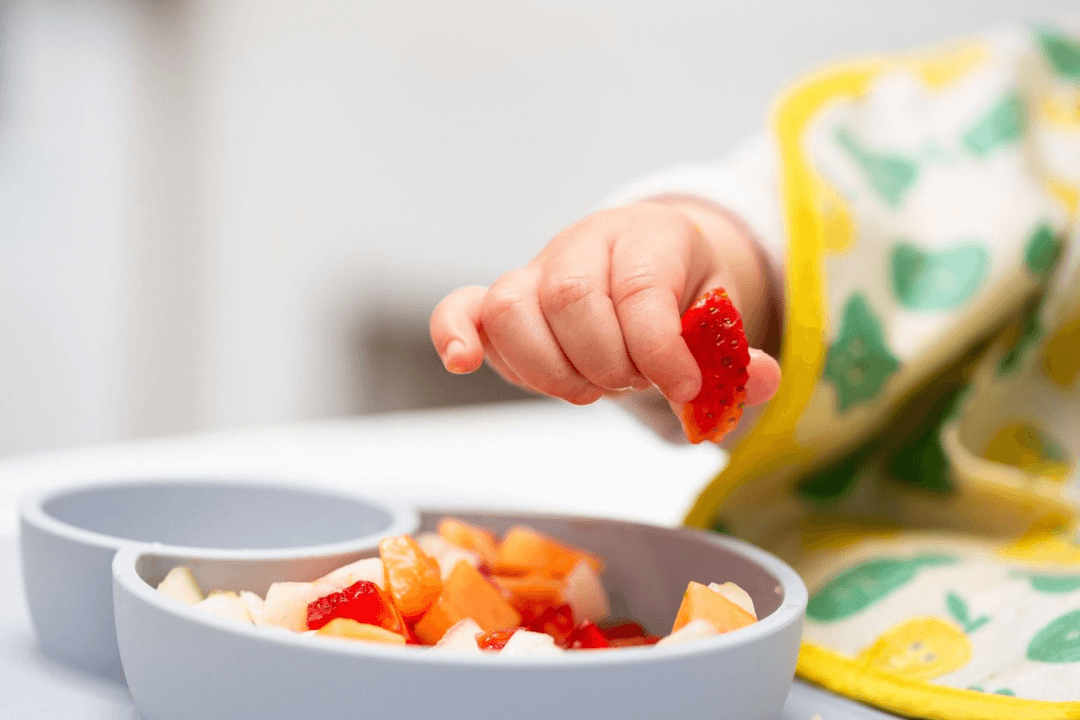Baby’s First Food: When to Introduce Solids to Feed Your Baby
As you embark on the exciting journey of introducing your little one to the world of solid foods, you might find yourself facing a sea of questions. When is the right time to start? What foods should you begin with? How do you ensure your baby gets the best nutrition?
In this guide, we’ll walk through the essential steps of introducing solids to your baby, offering tips and insights along the way.
When to Start – Ensuring Safety and Nutrition:
The American Academy of Pediatrics recommends waiting until your baby is between 4 to 6 months old before diving into the world of solid foods.
Why? Well, at this age, your baby’s digestive system is more mature, reducing the risk of allergies and ensuring they can handle a broader range of nutrients. So, sit back, relax, and enjoy those precious early months of exclusive breastfeeding or formula feeding.

Feeding Baby Infant Cereal
Feeding your baby infant cereal is a pivotal moment in their journey to solid food. Typically, infant cereals, (rice cereal or cereal from other grains) become one of the first solid foods for a baby to eat at home. Aim to start this adventure when your baby is around 4 to 6 months old, ensuring their tiny tummies are ready for the transition. These cereals are excellent sources of essential nutrients like iron, a crucial component for your baby’s growth and development.
When you begin feeding your baby infant cereal, consider mixing it with breast milk or formula to create a smoother texture, making it easier for your little one to swallow.
Start with small portions, perhaps a teaspoon or two, and gradually increase the quantity as your baby becomes more accustomed to the new taste and texture. Be patient, as every baby is different and may take some time to embrace this new experience.
Tips to Introduce Your Baby to Infant Cereal:
- Timing is Key:
Begin introducing infant cereal around 4 to 6 months when your baby shows signs of readiness. - Texture Matters:
Mix infant cereal with breast milk or formula to create a smoother texture initially. - Start Small:
Initiate with small portions, around a teaspoon or two, and gradually increase the quantity. - Be Patient:
Every baby is different; some may take time to embrace the new taste and texture of infant cereal. - Watch for Cues:
Pay attention to your baby’s cues. If they show disinterest, try again later or on another day.

Starting Baby on Baby Food
As your little one reaches around 6 months of age, it’s time to introduce a variety of pureed fruits and vegetables to their diet. These early experiences with different flavors and textures are not only exciting for your baby but also play a crucial role in establishing healthy eating habits in the future.
When introducing baby food, begin with single-ingredient purees like apples, sweet potatoes, or peas. This allows you to monitor your baby’s reaction to each new flavor and identify any potential allergies.
Gradually, you can blend different fruits and vegetables to create enticing combinations that stimulate their taste buds. As you venture into this phase of feeding, remember that patience is key.
Some babies may eagerly accept new foods, while others may need time to develop a liking for certain flavors.
Tips For Feeding Babies Solid Food (Baby Food):
- Timing Transition:
Start introducing pureed fruits and vegetables around 6 months as your baby’s palate develops. - Single Ingredients First:
Begin with single-ingredient purees to monitor for potential allergies and sensitivities. - Blend for Variety:
Experiment with blending different fruits and vegetables to create enticing flavor combinations. - Patience is Key:
Be patient if your baby doesn’t immediately take to certain flavors; it may take a few tries. - Progress Gradually:
As your baby becomes comfortable with purees, introduce a variety of foods, including meats and allergenic options.

When to Introduce Solid Table Foods
Transitioning your baby from purees to solid table foods is a significant milestone in their transition to solid food.
Typically, this phase occurs around 8 to 9 months of age, as your little one becomes more adept at chewing and swallowing. At this stage, their developing motor skills allow them to pick up small pieces of food, setting the stage for a more interactive and independent dining experience.
When deciding when to introduce solid table foods, observe your baby’s readiness cues. Can they sit up on their own? Have they developed the pincer grasp, enabling them to pick up small objects between their thumb and forefinger?
If so, your baby may be signaling that they are ready to graduate from purees to more textured, solid foods and finger foods.
Begin by offering soft, bite-sized pieces of cooked vegetables, fruits, and pasta. These foods not only provide essential nutrients but also encourage your baby to explore different textures and flavors.
Be present during meals, allowing your baby to experiment with self-feeding, even if it means a messier dining experience. Remember, this stage is not just about nourishment; it’s about fostering independence and a positive relationship with food.
Tips and Signs That Your Baby is Ready for Finger Food:
- Age-Appropriate Transition:
Introduce solid table foods around 8 to 9 months when your baby demonstrates the necessary motor skills. - Readiness Cues:
Watch for signs like independent sitting and the pincer grasp before introducing solid table foods. - Soft and Bite-Sized:
Begin with soft, bite-sized pieces of cooked vegetables, fruits, and pasta for easier handling. - Be Present:
Encourage self-feeding and be present during meals to create positive associations with food. - Embrace Messiness:
Understand that self-feeding may lead to messier mealtimes, but it’s a crucial part of your baby’s development.
When Your Child is Ready For Solid Food at Home
The transition to solid food is an exciting time for parent and child alike and important for development.
Taking your child through these steps not only nourishes them in the short-term, but also builds healthy eating habits for their long-term good. It is also a wonderful time of bonding with your child.
If you have any questions, feel free to contact us here. If you are looking for childcare, you can schedule a tour here. We would love to meet you!


